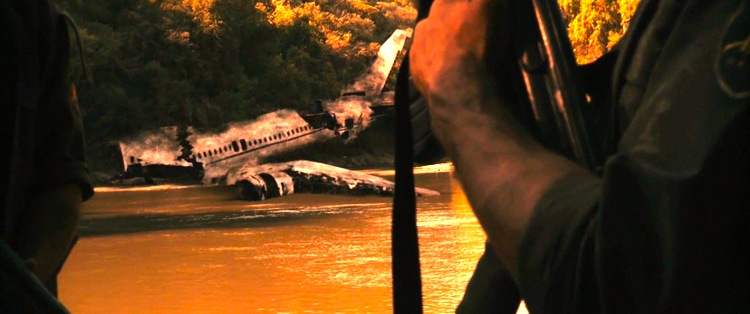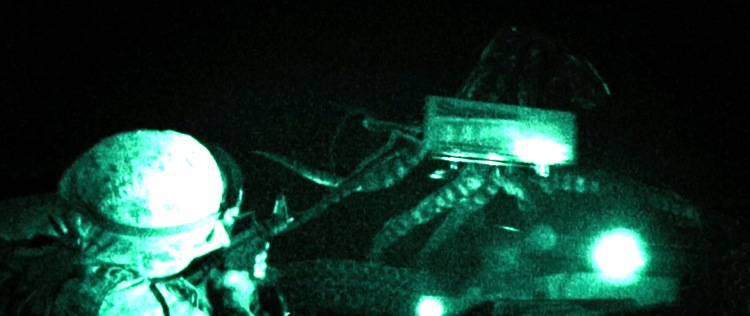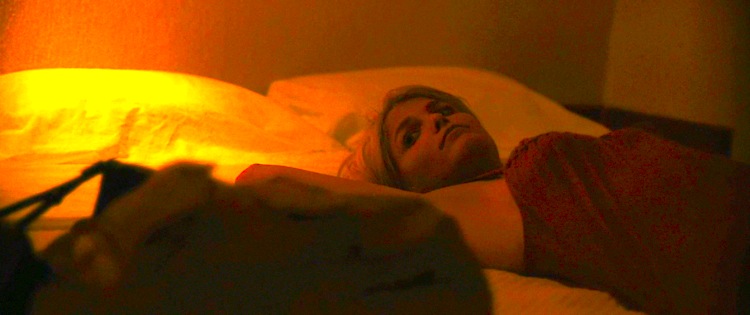
By Jason Apuzzo. For the past several months here at Libertas we’ve been covering the massive new wave of politically-charged ‘alien invasion’ projects that are about to be unleashed on moviegoers over the next two years or so. The origins of this intriguing new wave of films probably go back to 2008, when J.J. Abrams and Matt Reeves released Cloverfield, a sci-fi cult hit that played out as a kind of faux-documentary riff on the 9/11 attacks. [Abrams would also incorporate a 9/11-style attack on the planet Vulcan in 2009’s Star Trek.] Also in 2008 came Indiana Jones and the Kingdom of the Crystal Skull, George Lucas and Steven Spielberg’s affectionate riff on 1950s sci-fi invasion films, in which Dr. Jones confronts not only aliens (of a somewhat benign variety) but the Soviet communist menace, as well. Of course, the ‘alien invasion’ genre then got supercharged in late 2009 by James Cameron’s Avatar, which not only revived 3D but ‘politicized’ sci-fi to a degree unseen since the early 1950s.
One of the things that makes this new wave of films so interesting – and redolent of similar waves from the 1950s – is that it extends from the mega-big budget (e.g., the $200 million Battleship from Universal, starring Liam Neeson) to the low-budget (such as next month’s Skyline, made for under $10 million). And on a thematic level, although not all the plotlines are known for these films, many of them seem to be channeling political anxieties associated with terrorism, foreign threats, nuclear fears, as well as paranoia about the increasingly radical tone of American politics. [See my exchange with the LA Times’ Patrick Goldstein on this subject here.]
By the time this new wave of films peaks – probably about two years from now – Gareth Edwards’ Monsters (opening in select theaters today) is unlikely to be remembered as a high-water point of the genre, even for low-budget fare. Edwards’ film is too languorous, too derivative of other (and better) films to really linger in the memory. What Monsters does accomplish, however, is suggest how easily science fiction can be adapted to comment on contemporary political concerns.

The set-up for Monsters is relatively straight-forward. In the near future, America has sent space probes out into our solar system searching for microbial evidence of life. These probes have crashed back to Earth in the vicinity of the U.S.-Mexico border, where alien life forms brought back from space have swiftly grown into massive creatures – ‘monsters,’ that more or less look like grilled scampi – that have ravaged the countryside, and even major cities. The U.S. and Mexican militaries have thus conducted a massive (but largely futile) operation to both contain and destroy the creatures, resulting in urban warfare and endless bombing runs that have reduced many urban centers in Mexico to rubble. What’s more, we’re led to believe that the American bombing runs over Mexican cities have been far more devastating and lethal than the creatures themselves.
So in just the first few minutes of the film, we learn that this alien invasion is: a) America’s fault to begin with, and that; b) America’s overreaction to the crisis on its own border – HINT! HINT! – is worse than the initial crisis itself.
Tom Tancredo, this is not the film for you.
Into this mess on our border are thrown our two main characters, snarky American photojournalist Andrew Kaulder (Scoot McNairy) and wispy blonde Sam Wyden (Whitney Able), who happens to be the daughter of Kaulder’s employer. Monsters follows these two as they make their way illegally from Mexico up to through the quarantined, danger-filled border zone toward the U.S. border. Get it? See the irony? Two rich, callous gringos making their way illegally into the U.S. – and seeing what poor migrant workers have to go through!

It’s worth mentioning here that although Gareth Edwards seems very concerned with the devastation done to rural Mexico by the U.S. military in this (fictional) scenario – a scenario in which precision aerial strikes apparently don’t exist – he features no actual Mexican characters in his film with more than a few lines of dialogue. In Monsters Mexico exists simply as a picturesque background of suffering and corruption, redeemed only by the (supposedly) big liberal hearts of its two main WASP characters. Apparently Mr. Edwards didn’t want to muck up his film with too much non-WASP talent, as that might’ve hurt distribution chances for his film … in America, the same country for which he apparently has such contempt.
Monsters is shot and edited in a meditative, documentary-realist style, and – despite its somewhat lurid premise – has little interest in hitting the usual beats that alien invasion movies of this sort usually strike. Its main interest is in following the budding romance between Andrew and Sam, which in the hands of a more capable filmmaker might have played out something like the Clark Gable-Claudette Colbert road-romance from It Happened One Night. It doesn’t, however, because director Gareth Edwards – whose visual effects work in this film is polished, and even elegant in some places – is unable to create any compelling characterizations whatsoever. In Monsters we’re given to believe that the ability of the two main leads to overcome their innate differences – he’s a cynical, hard-scrabble photojournalist, while she’s a spoiled, quasi-heiress – is something akin to the ability of the human race to understand its new visitors from outer space. That analogy falls flat, however, because the main characters are so turgid and listless – and in the case of Andrew, downright obnoxious – that both their fate and the fate of the alien creatures fails to compel any interest whatsoever. In fact, I was personally rooting for Andrew the journalist to get crushed by the gambolling alien scampi – or perhaps wiped-out altogether in a boffo U.S. air strike. I didn’t get either.

In fairness, Monsters contains some nice suspense sequences about an hour in, as Andrew and Sam finally confront the alien creatures deep in the Mexican jungle – creatures whose appearance has only been teased (through news broadcasts) up to that point. These sequences play out like some of the better moments from Jurassic Park – quite an accomplishment, given that Monsters’ budget was reportedly under $1 million. Unfortunately the film is consistently dragged down by the two lifeless main characters, who never generate any heat or tension between each other – sexual or otherwise. The film’s occasional (and obvious) references to masterpieces like Fitzcarraldo or Apocalypse Now – similar journeys into a jungle’s ‘heart of darkness’ – don’t help matters, either. Monsters has no conception of what made those other films work: namely, tremendous characterizations, whether in the form of Klaus Kinski’s Fitzcarraldo or Marlon Brando’s Colonel Kurtz.
Monsters builds lazily to a climax at the U.S.-Mexico border, as our heroes finally reach the cold, dreaded, unfeeling United States – which in Monsters is surrounded by a gigantic border wall, a kind of high-tech version of China’s Great Wall. This is in some sense the film’s big ‘reveal’ – its signature FX shot, augmenting the apocalyptic landscapes of Mexico to which we’ve already been treated. Its purpose in the film is to suggest the kind of totalitarian society America is ostensibly becoming (in case you miss the point, Sam helpfully chirps at one point: “[I]t’s as if we’re building walls around ourselves“), although one can hardly blame America for erecting such a wall while the country is under assault by an interstellar seafood platter. Once over the wall, which (SURPRISE! SURPRISE!) has failed to keep out the highly illegal (and unearthly) aliens, Andrew and Sam find themselves trapped terrifyingly with a pair of the tentacled creatures at a gas station … only to witness a moment of tenderness between these alien calamari (cue Avatar), that is rudely and crassly interrupted by the U.S. military. Boo-hoo.

Whatever its shortcomings, Monsters is certainly a technical triumph in terms of showing what type of large-scale film can currently be done on a low budget. Its cinematography, sound design and editing are superb, as are its FX sequences – yet the film’s core is hollow, gimmicky, and churlish. Its lurid aliens-rampaging-through-Mexico premise is unlikely to excite snotty art house audiences; at the same time, its few action sequences don’t deliver enough of a cathartic kick to satisfy hard-core aficionados of the genre. So I expect the film to come and go from theaters quietly.
We will have to wait a few weeks for the release of the Strause brothers’ Skyline for the new ‘alien invasion’ genre to truly kick off in earnest. In the meantime, if you’re looking for a kind of mild, seafood appetizer – and a glimpse at the kind of political fireworks likely to come from this genre – you might want to give Monsters a try, but only if your politics are of the Avatar/Machete variety, and you prefer your characters on the shallow side of The Hills.

Posted on October 29th, 2010 at 4:11pm.
American military destroying innocent people trying to stop and unstoppable invasion by insurgents?
I blame Obama and the Democrats.
I agree … warmongers!
You know, every time I start writing anything, a novel, a short story, a poem, a blog post, even a comment to another blog, I try to ask myself if what I’m getting ready to say is actually somewhat new or at least not said recently. I’m under the impression that these liberal filmmakers aren’t particularly concerned about such things. I’m not naive enough to think that every movie has to be a uniquely new idea, but there should probably at least be an effort at such things. I’m starting to get offended not by the cheap shots, but by the fact that they are so lazy about it. What challenge is there in pointing out the same pieces of half digested food in the same regurgitation over and over again? Seriously, give us something that requires a modicum of thought to rebuke. Please. Don’t give us a Cloverfield ripoff with Machete’s story.
I agree, Shin. The only thing the film had going for it was its naturalistic documentary style. Had the filmmaker done more psychological probing into the characters, or created a more original scenario, it could’ve been something more special. As it is now, it’s a film with toxic politics that lacks an original voice.
If only the film had an “Evil Corporation” trope to go with it’s cliched it’s-all’-America’s-fault metaphor.
Actually, there is such a trope in the film. There is an inference that the girl’s father runs a corrupt media empire that thrives on chaos and bloodshed.
My goodness Jason, you don’t miss a thing!
Actually, BB, I miss things all the time! For example, I missed dinner while watching Monsters …
Jason –
Your review was dead on. I saw this movie on an HDnet channel on direct tv. It certainly didn’t look like a low budget movie – the effects were quite impressive. The movie however was not. There were many problems with the movie ranging from the lackluster chemistry between the two main characters and the hit-you-over-the-head political subtext.
Ultimately the movie was simply boring. I’m not sure the director knew what type of movie he wanted to make. Was it a romance? A sci-fi adventure? A road movie? My guess is he went for all three but failed on each count.
Thanks, Tim. My sense is that he wanted to do a kind of indie/art-house sci-fi flick – which is a legitimate thing to do, but which requires more originality than he brought to the table. The film should probably have been either a lot more lurid and exploitative, or else a lot more cerebral. It wasn’t enough of either. Another problem is that – from what I understand – he had his actors ad-lib a lot of the dialogue, which only makes sense if you’re working with top-flight talent.